Best Probiotics for Cold and Flu (+ 5 Ways they Help)
This post may contain affiliate links. Read my full disclosure here.
Up to 70% of our immune system resides in the gut, so if we want a healthy immune system, we need healthy guts. We’ll share the best probiotics for colds and flu, and how they work to help your immune system.

Note: It takes time to build up the numbers of protective organisms in your digestive track. For best results, start consuming probiotics before cold and flu season gets into full swing.
Best Probiotics for Cold and Flu
Some of the top probiotic strains shown to help for cold, flu and other viral infections include:
- Bacillus species
- Lactobacillus species
- Bifidobacterium species
- Saccharomyces boulardii
We want live and active cultures, and/or probiotics in spore form that can make it all the way into the intestinal tract.
Bacillus species are bacterium that form heat resistant spores that survive down into the intestinal tract. They help crowd out bad bacteria, and aid the body in nutrient absorption.
Lactobacillus species produce lactic acid, helping to reduce pH in the gut. As all home canners know, lower pH reduces the risk of bad microbe growth.
Bifidobacterium species live in the intestines and are some of the first bacteria to colonize the gut. They produce lactic and acetic acid, protect the gut lining, and produce antimicrobial chemicals to fight pathogenic bacteria.
These descriptions are simplified to highlight some of the main actions, but you can visit the studies below if you’d like more detailed information.
5 Ways Probiotics for Colds and Flu Help
Studies have shown the effectiveness of specific probiotics. Benefits include:
- Fewer fevers
- Less coughs and runny noses
- Faster recovery
- Less antibiotic use
- Reduced sick leave
We’ll share some studies below, but first, let’s review the basics of probiotics.
What are probiotics?
Probiotics are beneficial microorganisms similar to the “friendly” microbes found naturally in the body’s digestive tract. Where antibiotics aim to fight illness by killing “bad” bacteria, probiotics may help prevent colds and flu by boosting good microbe populations.
A healthy human body contains around 3o trillion human cells, and 39 trillion microbial cells in our microbiome. These microbiome cells include bacteria, fungi, and viruses.
Our microbiome cells are critical to good health, because these little buggers adapt and respond quicker than our human cells can. They cover our skin in a protective layer, and much of our digestive tract. While we start digestion with chewing and stomach acid, the key to proper nutrient absorption is a healthy microbiome.
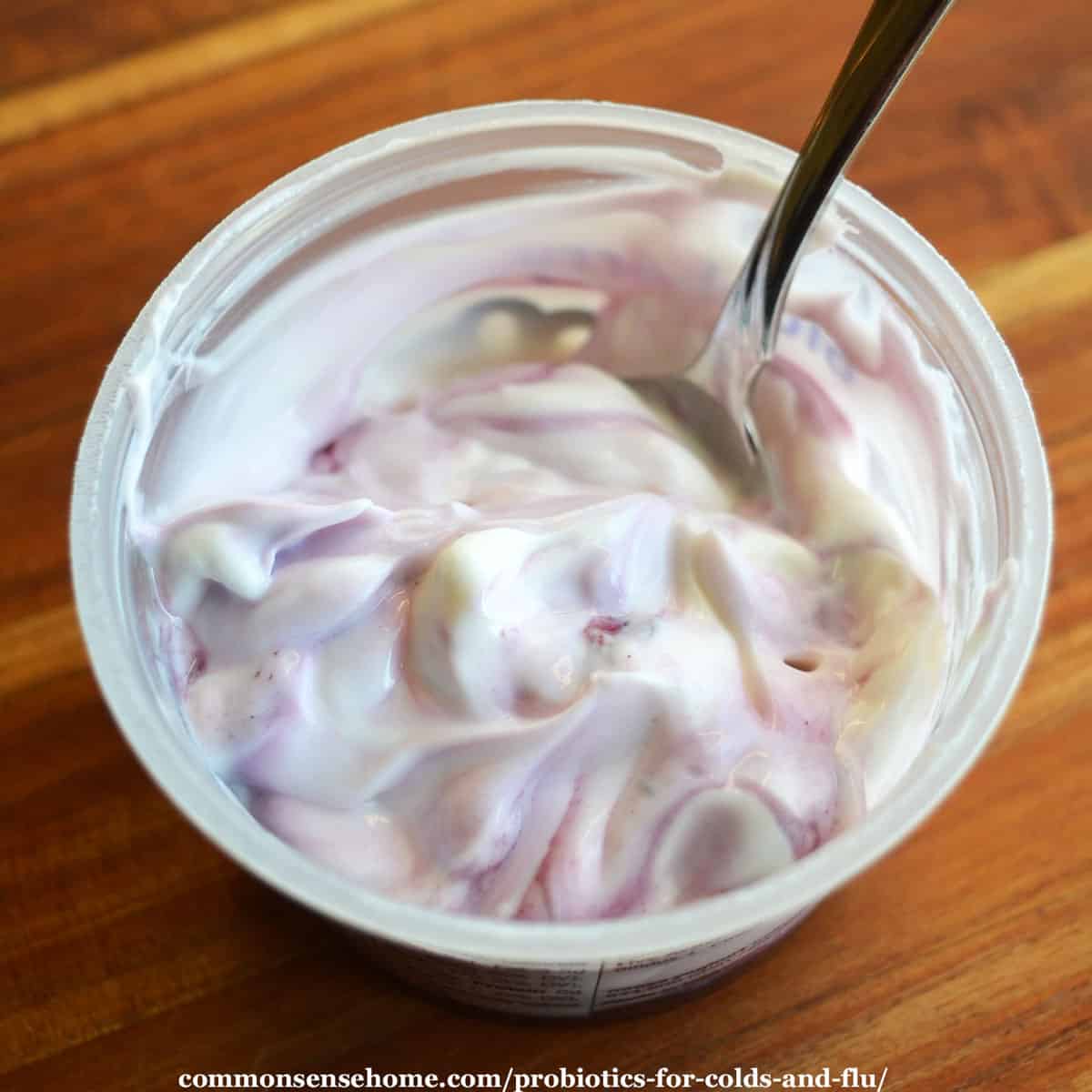
How do probiotics work?
Antibiotics work by killing bacteria, both friendly and unfriendly. Probiotics add good bacteria (and other microbes) to your body.
Adding more probiotic bacteria can crowd out the bad bacteria, at at the very least make it more difficult for them to thrive. Healthy microbes improve nutrient absorption, and strengthen the intestinal lining. They also appear to stimulate the innate immune response of the body.
Probiotics are generally free of side effects, but you should check with your doctor if you are on medication, as they may impact absorption. You should not take probiotics at the same time of day as antibiotics.
Studies Using Probiotic Supplements for Colds and Flu
An 18 month study that examined the effect of probiotics Lactobacillus acidophilus and Bifidobacterium animalis on children aged 3 to 5 showed fewer symptoms, faster recovery time and less antibiotic use.
Specifically:
- the Lactobacillus acidophilus group had 53% fewer fevers, 41% fewer coughs, and 28% fewer runny noses than the placebo group
- the group given both bacteria strains had 72% fewer fevers, 62% fewer coughs, and 59% fewer runny noses than the placebo group
- the Lactobacillus acidophilus group recovered from cold symptoms 32% faster and the two-bacteria group recovered 48% faster than the placebo group, when they did get sick, with less antibiotic use (68% and 84% less, respectively)
Would you like to save this?
A small Swedish study testing Lactobacillus reuteri found that workers using the probiotic reported no sick days, while 33% of the placebo group took sick leave.
Volunteers in a 2018 study received a probiotic drink containing Lactobacillus paracasei and Lactobacillus fermentium. The results indicated that the probiotics were effective in fighting the common cold and preventing respiratory infections.
In a double blind, parallel, placebo controlled study in Mexico, Bacillus coagulans decreased upper respiratory tract infection symptoms and duration in school aged children.
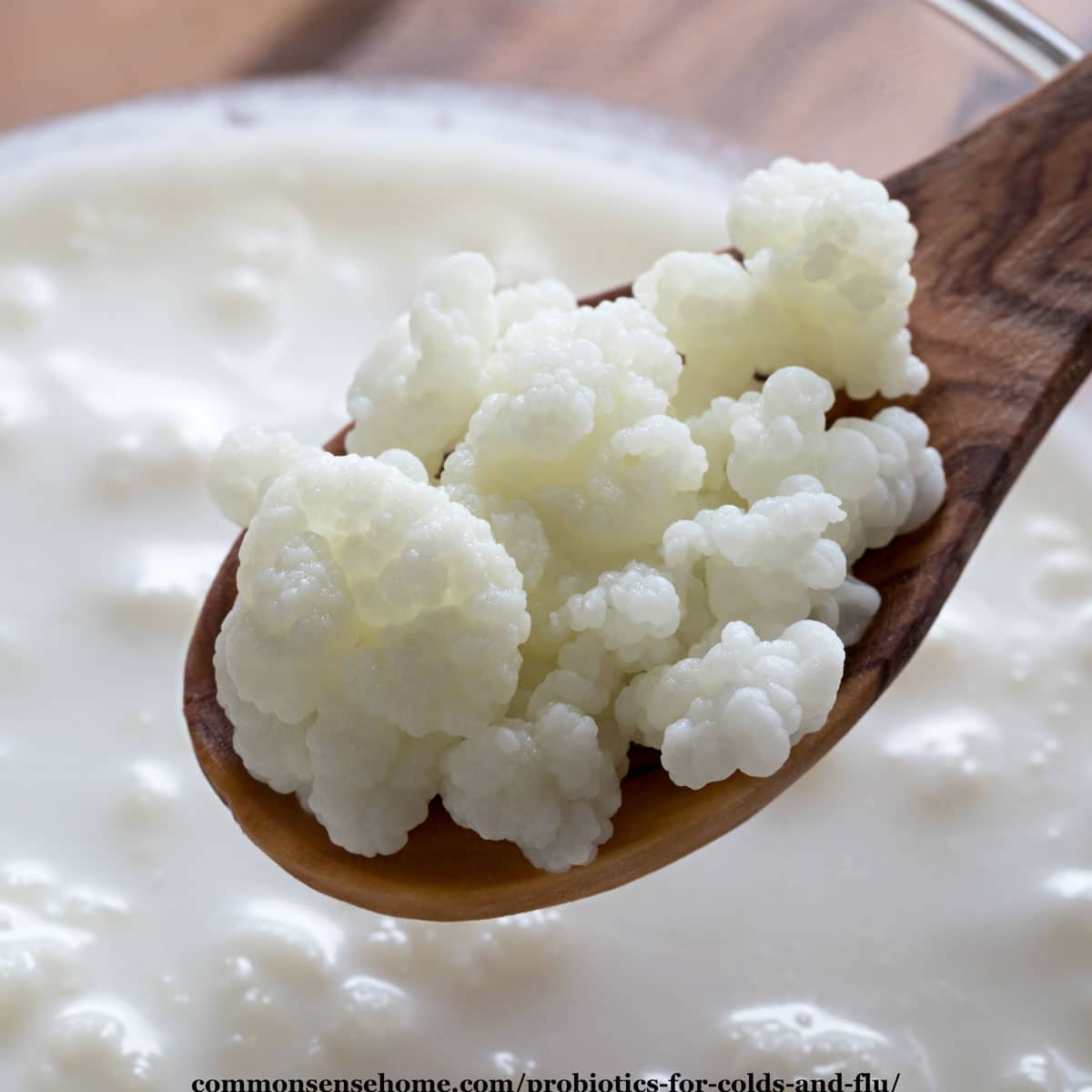
Using Naturally Fermented Foods for Colds and Flu
Commercial probiotics for cold and flu aren’t the only options. You can also use naturally fermented foods as a source of good microbes.
Any naturally fermented product (live culture food) that is not heat treated (pasteurized) can introduce good bacteria into your body.
Fermenting at home can provide healthy foods for pennies on the dollar compared to store products. You can also “sneak” probiotics in for fussy eaters (children or adults) by making snacks such as probiotic smoothies. Add milk kefir or pour a probiotic capsule into the smoothie mix.
Making probiotics at home takes a little time, because you need to ferment the food to give the good bacteria time to grow. You need basic kitchen equipment, like glass jars or crocks, to hold the food. Equipment like fermenting weights and airlocks are helpful for preventing contamination.
(These are the fermenting weights that we use for mason jars. Fermenting crocks work well for larger batches of food.)
Some fermented foods, like sauerkraut, start with just vegetables and salt. Other ferments use starter cultures to introduce specific probiotics.
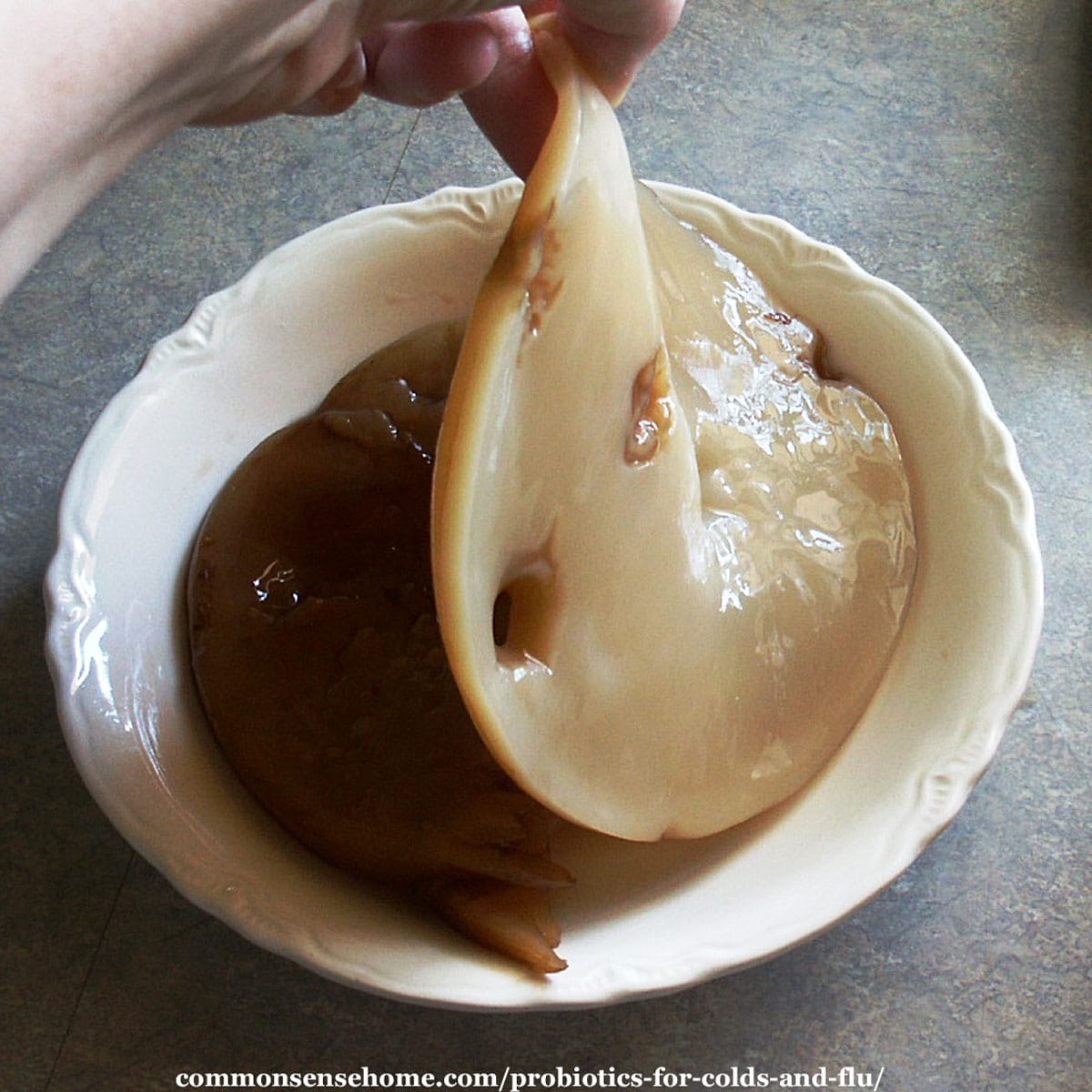
Some examples of fermented foods and drinks include:
- sauerkraut
- kimchi
- beet kvass
- naturally fermented sodas, wines, and beers
- kombucha
- kefir
- yogurt
We have instructions on the site for making several different fermented foods and beverages on the site. You can see the probiotic recipes here.
You can buy cultures to get started online, and you may be able to find them from friends (kefir grains and kombucha scobys may multiply when you brew). There are also online culture swap groups.
Kombucha Kamp is a reliable source for starter cultures, including scobys and kefir grains.
Which Probiotics are Best?
If you purchase probiotics for colds and flu, make sure you look for live and active cultures. Watch out for brands that are full of sugar and/or artificial ingredients. These work against your body’s ability to heal.
If you are in the middle of an active cold with phlegm production, non-dairy probiotic options are probably a better choice. (Choose fermented vegetables or supplements over yogurt or milk kefir.) The Art of Fermentation is a great book for learning how to make probiotic foods.
Florastor Select Immunity Boost offers a probiotic blend specifically focused on the immune system. It features Saccharomyces boulardii, along with zinc and vitamin C.
More Help for Cold and Flu Season
If you’ve found this post helpful, you may also enjoy other posts in the series, such as:
- Herbal Antibiotics
- Knock Out Cold and Flu Germs with Essential Oils
- The Best Supplements to Prevent and Treat Cold and Flu
- The Best Home Remedies for Stomach Flu Treatment
- Thieves Vinegar – Immune Booster and Germ Killer
Remember to always wash your hands, cough into your elbow, and contact a trained health care provider in case of serious illness.


This article is written by Laurie Neverman. Laurie is a lifelong learner with a passion for natural remedies and holistic healing. She’s successfully improved her eyesight, cleared her psoriasis, and gotten off of prescription medication.
Last updated in 2023.

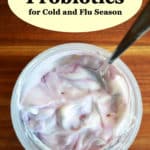
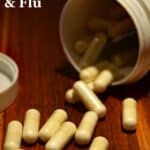


We have been enjoying homemade kefir for several at least twenty years using organic whole milk that is pasteurized, but not ultra high temperature pasteurized (too dead to culture, as far as we can tell.) Our local Super One just informed us that the diary that supplies it will not longer market organic milk.
Organic kefir has been a literal lifesaver for me, and triggered the end of decades of dysbiosis misery.
We have been unable to find any organic dairies within practical driving distance.
We are going to soldier on with commercial whole milk for now. It takes a little while for the kefir grains to adjust to a different quality of milk, and it is not quite that same as organic kefir.
We have hesitated to start our own home goat or sheep dairy. It would be a significant upgrade for our property, but far more practical than taking on the care and breeding of a dairy cow.
Oh,wow! More homestead adventures ahead!
Ultra high temperature pasteurization damages the milk so badly that you can’t make cheese with it, so I’m sure kefir grains wouldn’t like it, either. It’s so frustrating that almost every brand is switching to it.
Chlorophyll – the green blood of plants
Surely each of us knows at least one of the many benefits of chlorophyll. However, in recent years, more and more has been said about the many advantages and benefits of using liquid chlorophyll. We want to devote the following article to a detailed description of liquid chlorophyll that is available on the market (it is offered by many different manufacturers).
The benefits of chlorophyll were discovered many years ago. However, what chlorophyll is, what makes it unique, and what benefits can be derived from it is a very broad topic. We hope that after reading this article, you will be able to systematize your basic information about chlorophyll and its health benefits.
What is chlorophyll?
Chlorophyll is a green pigment found in plants. By absorbing solar energy, it conditions photosynthesis in plants. Chlorophyll is to them what blood is to humans. It is responsible in plants for metabolic functions such as growth and respiration.
Interestingly, the chlorophyll molecule is very similar in chemical structure to hemoglobin, the red pigment of human blood. The only difference is in the different central atom. Chlorophyll has magnesium in the center and iron in hemoglobin. This fact, and the fact that chlorophyll is essential for plant metabolism, prompted scientists to investigate the potential benefits of chlorophyll on human health.
Chlorophyll, like hemoglobin, has a great ability to combine with oxygen. Secondly, it absorbs toxins from cells very easily. In every part of the body, wherever it goes, as an ideal chelator, it always provides oxygen and takes with it waste products of metabolism that cells do not need. Chlorophyll therefore has particular benefits in diseases of the immune system, cancer and autoimmune diseases.
The body cleansing process plays an important role in the following processes:
– purification of blood, lymph and intracellular fluids,
– elimination of drug residues
– liver cleansing,
– inactivation and elimination of carcinogenic substances (substances causing oncological diseases),
– reducing the number of pathogenic bacteria, disinfects and detoxifies the body,
– receiving toxins, heavy metals and free radicals from cells
– maintaining the acid-base balance of the body.
Additionally:
– by regulating the work of the intestines, it helps to get rid of gases,
– balances blood pressure and breathing,
– disinfects wounds – kills bacteria in wounds,
– it is important in cleansing the digestive and excretory tract,
– removes bad breath and body odor.
– relieves the problems of excess sugar in the blood.
The first scientific data on chlorophyll was published in 1940 – but it was also a time to choke on antibiotics and their effects. Nevertheless, some scientists have conducted many years of research using chlorophyll in the treatment of dental diseases. Later, many studies appeared using chlorophyll in the treatment of e.g. pancreatitis, colorectal cancer, treatment of many infectious problems, etc.
Research has shown that chlorophyll plays a very important role in many processes in the body, including regulating the work of the cardiovascular, respiratory, digestive and excretory systems.
Thanks to the unique properties of chlorophyll, which is the activation of nitrogen transformation in the body, it has a strong antibacterial effect with high effectiveness both in light infections and colds as well as in strong and long-lasting inflammations, e.g. sinuses, skin or ulcers.
The strong anti-inflammatory effect of chlorophyll is shown in:
– counteracting inflammation: sore throat, pyoderma, gingivitis, inflammation and ulceration of the gastrointestinal mucosa,
– preventing tooth decay and gum disease,
– reducing the amount of catarrhal secretions,
– treatment of any inflammatory skin conditions,
– treatment of varicose veins,
– relieving the symptoms of painful hemorrhoids.
Chlorophyll – a green pigment found in most plants. It is the only substance in nature that stores sunlight, so it is essential for people who do not receive sunlight for any reason, e.g. office workers and residents of large cities, people tired and stressed.
An acidified body is a sick body!
According to prof. Ragnar Berg, an American nutrition expert, maintaining health depends on a daily diet. It should consist of 20% acidic foods and 80% alkaline foods. In a healthy body, the pH factor should be in the range of 7.3-7.4, which corresponds to an alkaline pH. A diet rich in acidic foods (meat, carbohydrates – from sweets, highly processed foods), in the long run, increasing the acidity of our body (acidifying it), causing disorders, inflammation, including heart disease, arthritis, higher blood pressure, strokes, diabetes, high cholesterol, etc.
To maintain the acid-base balance at the level of 7.35, a person must consume alkaline-rich foods, such as vegetables, fruit, shoots and sprouts, fruit in the shell, still mineral water, herbal teas. Unfortunately, the rush of life and contaminated food often prevent us from maintaining a healthy diet. To take care of our health, chlorophyll supplementation is necessary to balance our bad diet. According to scientists, the most beneficial for our body is chlorophyll in liquid form.
The chlorophyll in liquid obtained from alfalfa is especially valuable because alfalfa is one of the best sources of protein, chlorophyll, carotene, vitamin A (retinol), vitamins D, E, B6, K and several digestive enzymes. Due to a deep root system that allows for good absorption of minerals, alfalfa is a good source of calcium, magnesium, phosphorus, iron, potassium and trace elements.
It is recommended to use one teaspoon of liquid chlorophyll in a glass of water or other drink, drink it 2 to 3 times a day with meals.
This dosage of Chlorophyll plays an important role in the processes of restoring balance in the body, nutrition and regeneration of the body:
– supports the regeneration of red blood cells,
– improves the work of the thyroid gland and pancreas,
– prevents kidney stones,
– increases the body’s resistance,
– accelerates the wound healing process,
– accelerates the healing of ulcers,
– supports the development of a beneficial intestinal bacterial flora,
– activates enzymes to produce vitamins E, A, and K,
– provides oxygen to the brain and every cell of the body,
– improves the secretion of milk in nursing mothers,
– has a positive effect on lymphatic organs,
– strengthens the vascular system,
– supports the treatment of diabetes,
– relieves the symptoms of asthma,
– helps with anemia,
– can prevent pathological changes in DNA molecules,
– it can block the first stage of turning healthy cells into cancerous ones and prevent cancer,
– stimulates the oxidation process and stimulates the regeneration of cells in the body, thus preventing premature aging and arteriosclerosis,
– renews tissues (catalyzes cell renewal), rejuvenates the skin and helps to keep the body youthful,
– controls skin problems by eliminating free radicals,
– protects against harmful radiation,
– soothes the nervous state and reduces anxiety,
– Adds energy.
Products containing large amounts of chlorophyll:
Young barley
Chlorella in tablets
Spirulina
You just need to eat more green vegetables during the day to keep your body fit.
Eating healthy then we are not threatened by any corona viruses, or the like. I am a vegetarian and for over 6 years I have not had any colds, viruses or allergies. Not even for dust. A few years ago, Lyme disease forced me to change my diet, because drug treatment helped only a little. Lyme disease was just slowly taking away my vital functions – killing slowly but truly. Only the change of nutrition did wonders.
My daughter is also a vegetarian. All the children in her class are sick, and illnesses avoid her.
We are simply a living example of healthy eating. No chemicals, pills or vaccinations. Just vegetables.
PS. Information for everyone.
Please read my information again. You will save your life and family.
One more thing. Natural antibiotics include turmeric, ginger, and garlic, plus cloves. Natural probiotics include natural yoghurt, cooked barley porridge (its water too), sauerkraut and pickled cucumbers (in salt brine with appropriately selected herbs). Just nature itself.
Just wondering, I see no mention of kimchi? This is such a wonderful food, wouldn’t it help too?
I certainly suspect it would, as it’s likely high in vitamin C and healing spices, as well as active cultures. At the I wrote the post, we hadn’t started making kimchi at home yet, so I didn’t hunt around for studies on it.
Thanks, Jill.
Hi,
Your great post was featured at my Sunday Snippets this week. Come and check it out!
http://realfoodforager.com/2011/10/sunday-snippets-october-23-2011/
Treasures Evermore – be sure to stop in next weekend for the next installment.
Jill – I always enjoy Fat Tuesday. Lots of great links.
Thanks for linking your great post to FAT TUESDAY. This was very interesting! Hope to see you next week!
Be sure to visit RealFoodForager.com on Sunday for Sunday Snippets – your post from Fat Tuesday may be featured there!
http://realfoodforager.com/2011/10/fat-tuesday-october-18-2011/
If you have grain-free recipes please visit my Grain-Free Linky Carnival in support of my 28 day grain-free challenge! It will be open until November 2.
http://realfoodforager.com/2011/10/grain-free-real-food-linky-carnival/
What a great post…I cannot tell you how many things I just learned from reading this.
Thank you for all the info.
The hibiscus kombucha sounds yummy! I've been making kombucha and yogurt. Almost all 7 of us eat some type of probiotic food daily. We've had a few colds come through the family this fall, and almost all of it was pretty minor.
Now I'll go drink my kombucha!
With a shorter brew time (1 week) and some creative flavoring, the kombucha can be very tasty indeed. 🙂
I am definitely more of a water kefir person myself, but the hibiscus kombucha sounds pretty tempting indeed! I stopped over from Fat Tues!
Thanks, Allison.
Jeanette – I prefer kombucha, but my kids like water kefir better. It tends to have a milder flavor.
I've really been interested in trying the water kefir.
This is a great post! I will be sure to share it!
I have many Scoby mothers to give away if anyone is interested.